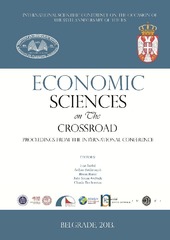Industrial Policy for Economic Development: The Perspectives for Serbia
2013
Аутори
Radovanović, Bojana
Kočović, Milica
Остала ауторства
Stošić, IvanRedžepagić, Srđan
Hanić, Hasan
Sousa Andrade, João
Barthomieu, Claude
Поглавље у монографији (Објављена верзија)
 ,
, Institut ekonomskih nauka
Метаподаци
Приказ свих података о документуАпстракт
This paper argues that industrial policy, defined as a conscious effort on the part of government to
encourage and promote a specific industry or sector, is an indispensable tool for economic
development. Serbia is experiencing a process of de-industrialisation since 1990s. During the period 2001-2012 its industry has been growing at an average annual rate of 0.2%, but it however still did not reach the output of the late 1989. The share of industry in GDP has been decreased, as well as the share in the labour productivity. Moreover, employment in industry has sharply decreased. Serbian exports are dominated mostly by primary and labour- and resource-intensive products making unfavourable export structure. This paper argues that devastated industry of Serbia cannot recover without conscious efforts on the part of government.
Кључне речи:
industrial policy / economic development / SerbiaИзвор:
Economic Sciences on the Crossroad, 2013, 216-226Издавач:
- Beograd : Institut ekonomskih nauka
Финансирање / пројекти:
- Европске интеграције и друштвено-економске промене привреде Србије на путу ка ЕУ (RS-MESTD-Integrated and Interdisciplinary Research (IIR or III)-47009)
- Изазови и перспективе структурних промена у Србији: стратешки правци економског развоја и усклађивања са захтевима ЕУ (RS-MESTD-Basic Research (BR or ON)-179015)
URI
http://www.library.ien.bg.ac.rs/index.php/zb/article/view/480http://rifdt.instifdt.bg.ac.rs/123456789/1526
Колекције
Институција/група
IFDTTY - CHAP AU - Radovanović, Bojana AU - Kočović, Milica PY - 2013 UR - http://www.library.ien.bg.ac.rs/index.php/zb/article/view/480 UR - http://rifdt.instifdt.bg.ac.rs/123456789/1526 AB - This paper argues that industrial policy, defined as a conscious effort on the part of government to encourage and promote a specific industry or sector, is an indispensable tool for economic development. Serbia is experiencing a process of de-industrialisation since 1990s. During the period 2001-2012 its industry has been growing at an average annual rate of 0.2%, but it however still did not reach the output of the late 1989. The share of industry in GDP has been decreased, as well as the share in the labour productivity. Moreover, employment in industry has sharply decreased. Serbian exports are dominated mostly by primary and labour- and resource-intensive products making unfavourable export structure. This paper argues that devastated industry of Serbia cannot recover without conscious efforts on the part of government. PB - Beograd : Institut ekonomskih nauka T2 - Economic Sciences on the Crossroad T1 - Industrial Policy for Economic Development: The Perspectives for Serbia SP - 216 EP - 226 UR - https://hdl.handle.net/21.15107/rcub_rifdt_1526 ER -
@inbook{
author = "Radovanović, Bojana and Kočović, Milica",
year = "2013",
abstract = "This paper argues that industrial policy, defined as a conscious effort on the part of government to
encourage and promote a specific industry or sector, is an indispensable tool for economic
development. Serbia is experiencing a process of de-industrialisation since 1990s. During the period 2001-2012 its industry has been growing at an average annual rate of 0.2%, but it however still did not reach the output of the late 1989. The share of industry in GDP has been decreased, as well as the share in the labour productivity. Moreover, employment in industry has sharply decreased. Serbian exports are dominated mostly by primary and labour- and resource-intensive products making unfavourable export structure. This paper argues that devastated industry of Serbia cannot recover without conscious efforts on the part of government.",
publisher = "Beograd : Institut ekonomskih nauka",
journal = "Economic Sciences on the Crossroad",
booktitle = "Industrial Policy for Economic Development: The Perspectives for Serbia",
pages = "216-226",
url = "https://hdl.handle.net/21.15107/rcub_rifdt_1526"
}
Radovanović, B.,& Kočović, M.. (2013). Industrial Policy for Economic Development: The Perspectives for Serbia. in Economic Sciences on the Crossroad Beograd : Institut ekonomskih nauka., 216-226. https://hdl.handle.net/21.15107/rcub_rifdt_1526
Radovanović B, Kočović M. Industrial Policy for Economic Development: The Perspectives for Serbia. in Economic Sciences on the Crossroad. 2013;:216-226. https://hdl.handle.net/21.15107/rcub_rifdt_1526 .
Radovanović, Bojana, Kočović, Milica, "Industrial Policy for Economic Development: The Perspectives for Serbia" in Economic Sciences on the Crossroad (2013):216-226, https://hdl.handle.net/21.15107/rcub_rifdt_1526 .

